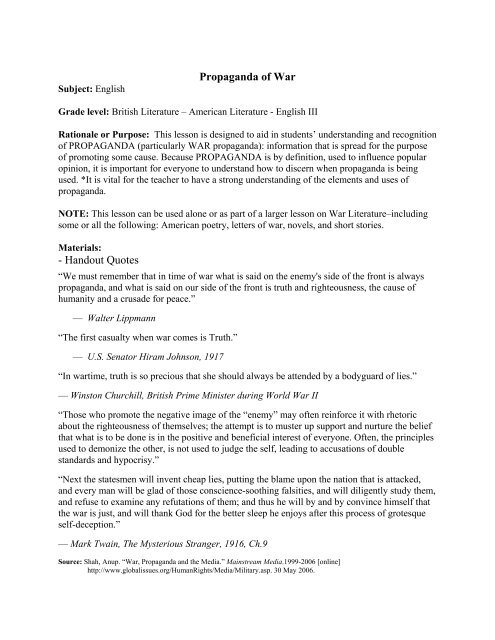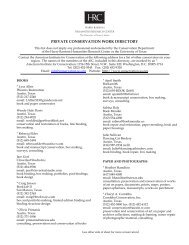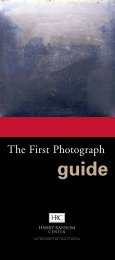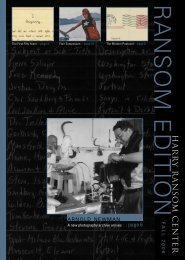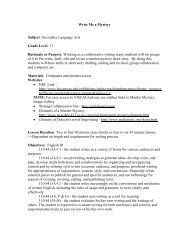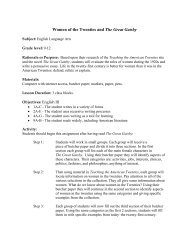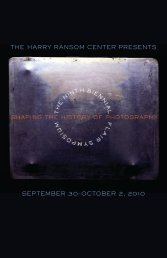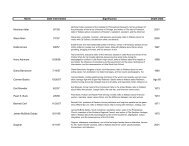Propaganda of War - Harry Ransom Center
Propaganda of War - Harry Ransom Center
Propaganda of War - Harry Ransom Center
Create successful ePaper yourself
Turn your PDF publications into a flip-book with our unique Google optimized e-Paper software.
Subject: English<br />
<strong>Propaganda</strong> <strong>of</strong> <strong>War</strong><br />
Grade level: British Literature – American Literature - English III<br />
Rationale or Purpose: This lesson is designed to aid in students’ understanding and recognition<br />
<strong>of</strong> PROPAGANDA (particularly WAR propaganda): information that is spread for the purpose<br />
<strong>of</strong> promoting some cause. Because PROPAGANDA is by definition, used to influence popular<br />
opinion, it is important for everyone to understand how to discern when propaganda is being<br />
used. *It is vital for the teacher to have a strong understanding <strong>of</strong> the elements and uses <strong>of</strong><br />
propaganda.<br />
NOTE: This lesson can be used alone or as part <strong>of</strong> a larger lesson on <strong>War</strong> Literature–including<br />
some or all the following: American poetry, letters <strong>of</strong> war, novels, and short stories.<br />
Materials:<br />
- Handout Quotes<br />
“We must remember that in time <strong>of</strong> war what is said on the enemy's side <strong>of</strong> the front is always<br />
propaganda, and what is said on our side <strong>of</strong> the front is truth and righteousness, the cause <strong>of</strong><br />
humanity and a crusade for peace.”<br />
— Walter Lippmann<br />
“The first casualty when war comes is Truth.”<br />
— U.S. Senator Hiram Johnson, 1917<br />
“In wartime, truth is so precious that she should always be attended by a bodyguard <strong>of</strong> lies.”<br />
— Winston Churchill, British Prime Minister during World <strong>War</strong> II<br />
“Those who promote the negative image <strong>of</strong> the “enemy” may <strong>of</strong>ten reinforce it with rhetoric<br />
about the righteousness <strong>of</strong> themselves; the attempt is to muster up support and nurture the belief<br />
that what is to be done is in the positive and beneficial interest <strong>of</strong> everyone. Often, the principles<br />
used to demonize the other, is not used to judge the self, leading to accusations <strong>of</strong> double<br />
standards and hypocrisy.”<br />
“Next the statesmen will invent cheap lies, putting the blame upon the nation that is attacked,<br />
and every man will be glad <strong>of</strong> those conscience-soothing falsities, and will diligently study them,<br />
and refuse to examine any refutations <strong>of</strong> them; and thus he will by and by convince himself that<br />
the war is just, and will thank God for the better sleep he enjoys after this process <strong>of</strong> grotesque<br />
self-deception.”<br />
— Mark Twain, The Mysterious Stranger, 1916, Ch.9<br />
Source: Shah, Anup. “<strong>War</strong>, <strong>Propaganda</strong> and the Media.” Mainstream Media.1999-2006 [online]<br />
http://www.globalissues.org/HumanRights/Media/Military.asp. 30 May 2006.
- From <strong>Ransom</strong> <strong>Center</strong> Collection:<br />
Couglin, John A. First in France. U. S. Marines. Poster, 1917-1918.<br />
Sidney H. Riesenberg. Lend as they Fight, Buy more Liberty Bonds. Poster, 1917.<br />
Henry Raleigh. Halt the Hun. Buy U. S. Government Bonds. Poster, 1918.<br />
Howard Chandler Christy. I Want You for the Navy. Poster, 1917.<br />
Charles Livingston Bull. Keep Him Free. Poster, 1917-1918.<br />
OTHER:<br />
*Other miscellaneous <strong>War</strong> <strong>Propaganda</strong> (i.e. Posters, news reels, etc.)<br />
*Computer access and Micros<strong>of</strong>t Word or PowerPoint s<strong>of</strong>tware (clipart or other images) OR poster paper (or<br />
butcher paper), markers, colored pencils, crayons, and magazines – which can be used in lieu original art<br />
work<br />
Possible LINKS:<br />
http://www.library.georgetown.edu/dept/speccoll/amposter.htm<br />
http://www.firstworldwar.com/posters/index.htm<br />
http://europeanhistory.about.com/gi/dynamic/<strong>of</strong>fsite.htm?site=http%3A%2F%2Fgulib.lausun.ge<br />
orgetown.edu%2Fdept%2Fspeccoll%2Fbritpost%2Fposters.htm<br />
http://europeanhistory.about.com/gi/dynamic/<strong>of</strong>fsite.htm?site=http%3A%2F%2Fwww.pma.edm<br />
onton.ab.ca%2Fvexhibit%2Fwarpost%2Fenglish%2Fhome.htm<br />
http://europeanhistory.about.com/gi/dynamic/<strong>of</strong>fsite.htm?site=http%3A%2F%2Fwww.theforum.com%2Fposters%2Fwarpost1.htm<br />
http://europeanhistory.about.com/gi/dynamic/<strong>of</strong>fsite.htm?site=http%3A%2F%2Fwww.worldwar<br />
1.com%2Fposters.htm<br />
http://www.historians.org/Projects/GIroundtable/index.html<br />
Lesson Duration: Maximum <strong>of</strong> two 90 minute Blocks or four 45 minute lessons (Time will vary<br />
depending on availability <strong>of</strong> computers, Internet, etc. AND on student ability levels.)<br />
Objectives:<br />
TEKS 1, A - write in a voice and style appropriate to audience and purpose<br />
TEKS 4, D - represent information in a variety <strong>of</strong> ways such as graphics, conceptual maps, and<br />
learning logs<br />
TEKS 4, E - use writing as a study tool to clarify and remember information<br />
TEKS 7, H - use study strategies such as note taking, outlining, and using study-guide questions<br />
to better understand texts<br />
TEKS 12, B - evaluate the credibility <strong>of</strong> information sources, including how the writer's<br />
motivation may affect that credibility; and
TEKS 12, C - recognize logical, deceptive, and/or faulty modes <strong>of</strong> persuasion in texts.<br />
TEKS 14, A - demonstrate pr<strong>of</strong>iciency in each aspect <strong>of</strong> the listening process such as focusing<br />
attention, interpreting, and responding<br />
TEKS 14, E - use effective listening to provide appropriate feedback in a variety <strong>of</strong> situations<br />
such as conversations and discussions and informative, persuasive, or artistic presentations.<br />
TEKS 15, A - use the conventions <strong>of</strong> oral language effectively;<br />
TEKS 15, B - use informal, standard, and technical language effectively to meet the needs <strong>of</strong><br />
purpose, audience, occasion, and task;<br />
TEKS 15, C - communicate effectively in conversations and group discussions while problem<br />
solving, and planning;<br />
TEKS 15, D - use effective verbal and nonverbal strategies in presenting oral messages;<br />
TEKS 15, E - ask clear questions for a variety <strong>of</strong> purposes and respond appropriately to the<br />
questions <strong>of</strong> others; and<br />
TEKS 15, F - make relevant contributions in conversations and discussions.<br />
Activity:<br />
Step 1: Introduce Students to the definition and elements <strong>of</strong> <strong>Propaganda</strong>. This can be<br />
accomplished with a handout, a PowerPoint presentation and/or through note taking and lecture.<br />
Handout –<br />
Definition – <strong>Propaganda</strong> is a specific type <strong>of</strong> message presentation directly aimed at influencing<br />
the opinions <strong>of</strong> people, rather than impartially providing information (Wikipedia).<br />
Elements <strong>of</strong> <strong>Propaganda</strong><br />
<strong>Propaganda</strong> can serve to rally people behind a cause, but <strong>of</strong>ten at the cost <strong>of</strong> exaggerating,<br />
misrepresenting, or even lying about the issues in order to gain that support.<br />
While the issue <strong>of</strong> propaganda <strong>of</strong>ten is discussed in the context <strong>of</strong> militarism, war and warmongering,<br />
it is around us in all aspects <strong>of</strong> life.<br />
As the various examples below will show, common tactics in propaganda <strong>of</strong>ten used by either<br />
side include:<br />
• Using selective stories that come over as wide-covering and objective.<br />
• Partial facts, or historical context<br />
• Reinforcing reasons and motivations to act due to threats on the security <strong>of</strong> the<br />
individual.<br />
• Narrow sources <strong>of</strong> “experts” to provide insights in to the situation. (For example, the<br />
mainstream media typically interview retired military personnel for many conflict-related<br />
issues, or treat <strong>of</strong>ficial government sources as fact, rather than just one perspective that<br />
needs to be verified and researched).
• Demonizing the “enemy” who does not fit the picture <strong>of</strong> what is “right”.<br />
• Using a narrow range <strong>of</strong> discourse, whereby judgements are <strong>of</strong>ten made while the<br />
boundary <strong>of</strong> discourse itself, or the framework within which the opinions are formed, are<br />
<strong>of</strong>ten not discussed. The narrow focus then helps to serve the interests <strong>of</strong> the<br />
propagandists.<br />
Word Games<br />
Name-calling<br />
Labeling people, groups, institutions, etc in a negative manner<br />
Glittering generality<br />
Labeling people, groups, institutions, etc in a positive manner<br />
Euphemisms<br />
Words that pacify the audience with blander meanings and connotations<br />
False Connections<br />
Transfer<br />
Using symbols and imagery <strong>of</strong> positive institutions etc to strengthen acceptance<br />
Testimonial<br />
Citing individuals not qualified to make the claims made<br />
Special Appeal<br />
Plain Folks<br />
Leaders appealing to ordinary citizens by doing “ordinary” things<br />
Band Wagon<br />
The “everyone else is doing it” argument<br />
Fear<br />
Heightening, exploiting or arousing people's fears to get supportive opinions and actions<br />
Source: Shah, Anup. “Elements <strong>of</strong> <strong>Propaganda</strong>.” Mainstream Media.1999-2006 [online]<br />
http://www.globalissues.org/HumanRights/Media/Military.asp. 30 May 2006.<br />
Step 2: Share and discuss the quotes and how they relate to propaganda.<br />
Step 3: Show students the <strong>Ransom</strong> <strong>Center</strong>’s WWI posters (Big Debates–After The <strong>War</strong>)<br />
and as a class, look for any elements <strong>of</strong> propaganda. Using the chalkboard, overhead projector or<br />
document projector jot down elements used and student comments.<br />
Step 4: Put students into teams <strong>of</strong> 2 or 3 and (if computers are available use internet or<br />
online sources viewing other war posters) provide each team with examples <strong>of</strong> a variety <strong>of</strong> war<br />
posters. Then have each team analyze at least 4 different posters for the elements <strong>of</strong> propaganda.<br />
Have each team write down or type descriptions <strong>of</strong> the elements used, how these elements were<br />
used and to what effect.<br />
Step 5: NOW have the teams create their own war posters.<br />
- This can be accomplished using PowerPoint, Micros<strong>of</strong>t Word or poster paper<br />
or butcher paper with markers, colors, colored pencils and perhaps magazine<br />
clippings.<br />
- Then have the students explain in writing how their poster meets the<br />
qualifications <strong>of</strong> propaganda.<br />
Step 6: Have student share posters with class and to explain which and how the elements<br />
<strong>of</strong> propaganda are used, using their written explanations as a guide.
Modification:<br />
NOTE: This lesson can be modified for teaching British Literature, and can also be enhanced by<br />
incorporating war posters from both “sides” <strong>of</strong> the battle.<br />
Student Product:<br />
— Notes over propaganda<br />
— Team notes on war poster analysis<br />
— Team <strong>War</strong> Posters<br />
— Written <strong>War</strong> Posters descriptions and explanations<br />
— Poster sharing presentations<br />
Closure: Evaluate the final posters Does the poster effectively propagandize some aspect <strong>of</strong> the<br />
war? What could be improved to enhance the concept <strong>of</strong> propaganda?<br />
Assessment or evaluation:<br />
- Check propaganda notes for completion (use for future quizzes or test on<br />
propaganda).<br />
- Evaluate (with a rubric) the team notes on analysis.<br />
- Use a simple rubric to score the team poster and written descriptions and<br />
explanations.<br />
- Finally, use a presentational speech rubric to evaluate the final presentation –<br />
one that evaluates multiple speakers who are all required to speak about the<br />
poster.<br />
Extension: As noted above, this lesson could be used as part <strong>of</strong> a Literature <strong>of</strong> <strong>War</strong> Unit, or it<br />
could be extended by creating more contemporary war posters and propaganda – Korea,<br />
Vietnam, Cold <strong>War</strong>, <strong>War</strong> in Iraq, <strong>War</strong> Against Terrorism. You could have students create full<br />
<strong>War</strong> <strong>Propaganda</strong> brochures (pamphlets) by using examples <strong>of</strong> longer war propaganda pieces.<br />
Laurie A. Coker<br />
Westwood High School<br />
Austin, Texas


